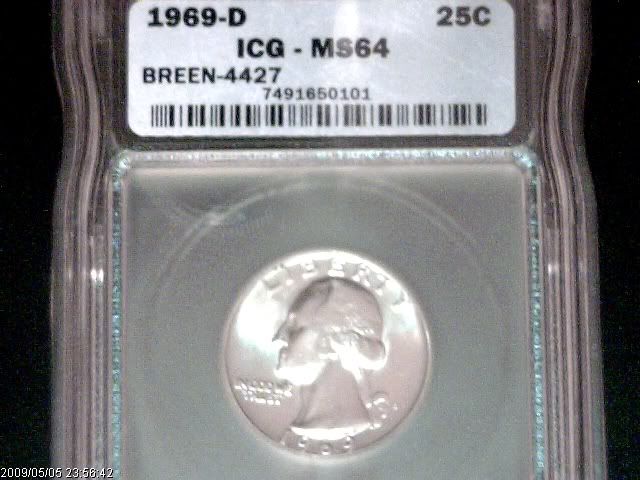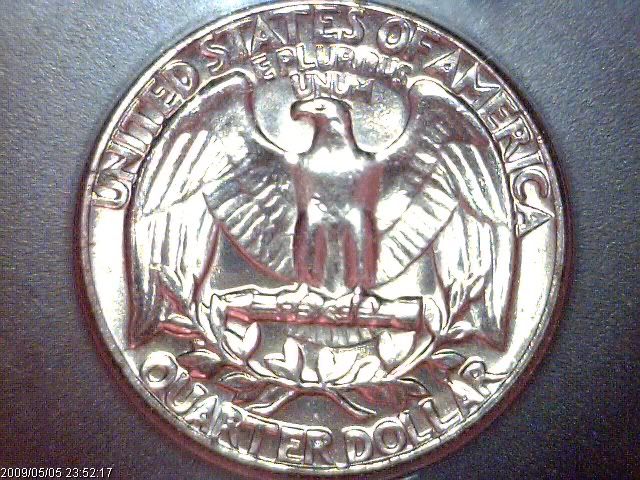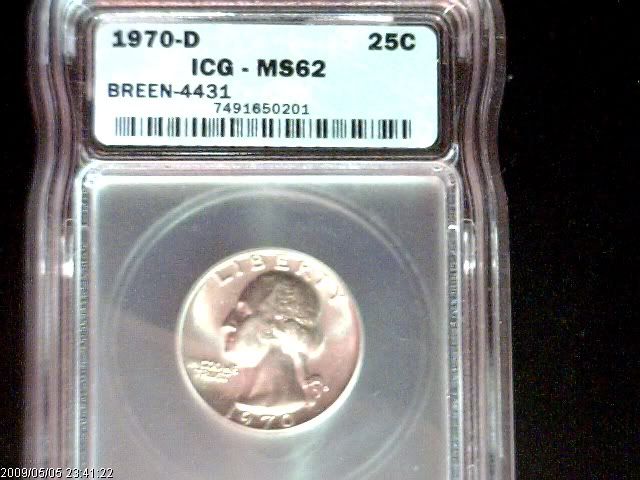Clad Denver Mint B Reverse Quarters - just in - pics
 dlmtorts
Posts: 731 ✭✭✭
dlmtorts
Posts: 731 ✭✭✭
I joined this forum in January to ask if these should be submitted for grading and authentication. I finally have them back in hand so here are the pics!

 http://i638.photobucket.com/albums/uu107/dlmtorts01/1969-dbRevObverse-1.jpg">
http://i638.photobucket.com/albums/uu107/dlmtorts01/1969-dbRevObverse-1.jpg">






0
Comments
But I only see the 1969 D. Where is the 1970 D? Oops! Now I see it.
Actually my navigation of this forum tonight is proving to be quite flaky.
1969-d
(edited again to correct my screwup in attaching photo!)
Breath taking. Both those reverses look a littlle PL.
Click on this link to see my ebay listings.
Proofartwork - The tes - o does not stick above the rim - closeup of the 1970-d attached.
Certainly clad and type B and uncirculated is quite rare. I have been saving these since 1973 and haven't got one myself yet.
In one sense circulated 1969 D B should not be that rare. Back in 1973 I was finding 1 B out of every 114 1969 D's out of every 4,000 quarters. That is almost 1% of the 1969 D or about 1,000,000 minted. I can hardly find any 1969 D in circulation today and it is very rare for a B to show up in the market. Sometimes, I fear this may be lack of interest rather than rarity.
1970 D B was 1 in 724 in my experience. At that, I have been told that I was extraordinarily lucky.
1971 D B was 1 in 2,783. All seem to have the same die chip, hence a one die phenomenon.
1972 D B was 1 in 8,316 1972 D or 1 in every 357,760 quarters.
Thanks for the info!
<< <i><<Is this very rare... being clad and type B ?>>
Certainly clad and type B and uncirculated is quite rare. I have been saving these since 1973 and haven't got one myself yet.
In one sense circulated 1969 D B should not be that rare. Back in 1973 I was finding 1 B out of every 114 1969 D's out of every 4,000 quarters. That is almost 1% of the 1969 D or about 1,000,000 minted. I can hardly find any 1969 D in circulation today and it is very rare for a B to show up in the market. Sometimes, I fear this may be lack of interest rather than rarity.
1970 D B was 1 in 724 in my experience. At that, I have been told that I was extraordinarily lucky.
1971 D B was 1 in 2,783. All seem to have the same die chip, hence a one die phenomenon.
1972 D B was 1 in 8,316 1972 D or 1 in every 357,760 quarters. >>
What's remarkable is that this is a lower incidence of '09-S VDB cents in circulation
after most had been set aside and gleaned from pocket change. The type "b" re-
verses are almost all in circulation except for about half which have been destroyed
by time and tide. There's very little chance that many will be saved from their event-
ual fate since they are so hard to find.
The typical grade of these coins now is VG+/ F and higher grade examples will prove
scarce.
It's remarkable that if not for the '70 in the mint set this would be a tough type coin
in any grade.
It certainly seems that there are many varieties in the clad coins and that they have not yet been recognized by most collectors! Consequently, high grade examples may be tough to come by.
<< <i>I know that the 1972 Quarters in Mint Sets are a different variety again. They are visibly different than the regular circulation coins. When did that start? Are they different before 1972 or are the mint set coins prior to that the same as regular circulation strikes? >>
I confess you have me at an advantage here. I don't
think I ever noticed a difference between mint set and
regular issue '72 quarters. The obverse relief may be
a little different but I'm aware of no PUP.
Generally the mint set coins are the same but contain
fewer varieties.
<< <i>
It certainly seems that there are many varieties in the clad coins and that they have not yet been recognized by most collectors! Consequently, high grade examples may be tough to come by. >>
There are varieties in circulation and in mint sets that
are very poorly reported or unreported. I've never un-
derstood why the dramatic '77 to '84 type "d" rever-
ses get so little attention. One of these even appears
in the mint sets.
I know I'm going to start paying a lot more attention
to these and not dismiss so many.
<< <i>Maybe I am way off base on that - but I thought that was the case. I'll defer to your expertise. >>
Perhaps you shouldn't.
There are a lot of differences that I tend to ascribe to hubbing
differences even though they might sometimes go beyond this.
The 1974-P seems to come with two different reliefs or field
heights but there are too many hybrids for this to actually be
a variety I believe.
The '85-P has a more identifiable difference that is difficult to
ascribe to different numbers of hubbings from one die to anot-
her. While the relief is different so too is the distance between
the "E" in "LIBERTY" and Washington's head. These account
for about 1% of production and are tough in unc.
heights but there are too many hybrids for this to actually be
a variety I believe.>>
I find this very interesting. Don't give up just yet. How many different interim ones do you have? It sounds very much like my 1970 D type M versus regular circulation strike. I had the M and the regular and I was finding also apparent hybrid coins that looked like they were 88% of the way to an M, 50% M, 25% M and 12% M. I was ready to give up. But thank heavens, I had the 1968 S and 1969 D with only one M type. I then realized that we had about 100 different doubled dies in the 1970 D with many different characteristics, allbeit with few spectacular enough to sell. Maybe the clad B's never made the CPG, but two of the doubled dies involving M did.
I have a thread with pictures of an M and a doubled die involving an M. I will post the address shortly and maybe Cladking can give us a real link.
Here it is: http://forums.collectors.com/messageview.cfm?catid=26&threadid=627990&highlight_key=y&keyword1=1970
in any grade>>
How many 1970 Mint sets had type B? I was not aware any did. Most 1970 D's in mint sets in my limited experience were type M, a few regular business strike and a very few doubled die coins.
Great info here........
The name is LEE!
I used to search for "type B" which would skip this one. I now search for " B " which brings up some I missed and some extra junk I have to ignore. I would still miss anything that had characters abutting the B.
Or in the words of Jean-Paul Sartre.....TRES BIEN! (I think he said that, right after he said "Au revoir, gopher."!!)
Hoard the keys.
I used to be famous now I just collect coins.
Link to My Registry Set.
https://pcgs.com/setregistry/quarters/washington-quarters-specialty-sets/washington-quarters-complete-variety-set-circulation-strikes-1932-1964/publishedset/78469
Varieties Are The Spice Of LIFE and Thanks to Those who teach us what to search For.
The 1972 D B sold to the second bidder for $305 plus about $15 shipping.
The 1970 D B sold for $150 plus about $15 shipping.
The 1969 D B did not sell at $100 (reserve not met), but is now reoffered as buy it now for $150.
Have now done 3 edits for clarification.
<< <i>There were recently 3 clad typ B Denver mint quarters on Ebay. That is a rare event, indeed.
The 1972 D B sold to the second bidder for $305 plus about $15 shipping.
The 1970 D B sold for $150 plus about $15 shipping.
The 1969 D B did not sell, but is now reoffered as buy it now for $150. >>
Were all of these uncs?
None were uncs. I have now edited my recent post.
The name is LEE!
<< <i>There were recently 3 circulated clad type B Denver mint quarters on Ebay. That is a rare event, indeed.
The 1972 D B sold to the second bidder for $305 plus about $15 shipping.
The 1970 D B sold for $150 plus about $15 shipping.
The 1969 D B did not sell at $100 (reserve not met), but is now reoffered as buy it now for $150.
Have now done 3 edits for clarification. >>
I and the seller (of course he doesn't know this) wish I'd seen these on eBay as the prices would have been much higher.
These are really very difficult to find as it requires going through a lot of quarter rolls. Of course, buying UNC rolls is a 99 out of a 100 bust since nearly all the rolls are "put togethers" from mint sets and these reverses simply did not appear in mint sets. It makes the hunt very frustrating and very expensive since reselling the rolls can prove to be difficult.
I expect that these will be very rare in the future but only appreciated by those folks that have any interest in these reverse types. Unfortunately, the 69-D looks pretty beat up and has at least one roller mark on the obverse. This could prove ungradeable although if PCGS truely recognized the rarity of the piece, they might just grade it.
Of course, getting a PCGS attribution for the 69-D has little meaning compared to the current rarity of the piece and simply owning one. I won't regret this purchase one bit.
The name is LEE!
<< <i>I am going to submit pics to CPG so maybe the Clad B's will be in the next edition. >>
There WILL be a new and greatly improved section in the CPG V, II concerning the different Washer reverses, including these clads.
Exactly when the book gets released is now the big question, as the author has had some difficulties as of late.
<< <i>[]I and the seller (of course he doesn't know this) wish I'd seen these on eBay as the prices would have been much higher.
These are really very difficult to find as it requires going through a lot of quarter rolls. Of course, buying UNC rolls is a 99 out of a 100 bust since nearly all the rolls are "put togethers" from mint sets and these reverses simply did not appear in mint sets. It makes the hunt very frustrating and very expensive since reselling the rolls can prove to be difficult.
I expect that these will be very rare in the future but only appreciated by those folks that have any interest in these reverse types. Unfortunately, the 69-D looks pretty beat up and has at least one roller mark on the obverse. This could prove ungradeable although if PCGS truely recognized the rarity of the piece, they might just grade it.
Of course, getting a PCGS attribution for the 69-D has little meaning compared to the current rarity of the piece and simply owning one. I won't regret this purchase one bit. >>
I think in the long run these are going to be highly sought after. Indeed there will be demand
for all of the varieties and the more easily distinguished they are the greater will be the demand.
The clad coins simply weren't saved. Mint sets were made but these are continuing to get used
up at a phenomenal rate and eventually won't be sufficient even for the paltry demand. But the
varieties don't even appear in mint sets and most weren't saved. As demand comes about col-
lectors will have to get the coins from circulation and these look worse year after year. They're
already down to VG (Fine with extreme effort) and none are improving. What better memento of
the era than coins that are scarce in any grade and rare in nice condition? What says more about
an era of carefree waste than coins that can't even be found in Unc or AU because people were
consumed by finding silver or old coins?
Historically people have tended to undersave new coin simply because it was new but few eras
have been so adamant about avoiding new issues than the modern coin era. Most moderns from
all over the world are scarce or rare.
None of the clads will prove tough in lower grades but many have been scarce in nice condition
since the day they were new. Well, the type 'b" and later type "d" will prove challenging in most
grades as will most all of the varieties. Most collectors will have to settle for what's available and
that's going to be VG's and lower. Most collectors will have to do without unless they find it them-
selves or can afford the price. Scarcity has a way of causing demand when it comes to collectibles
and there's no reason this won't apply to the type "d's".
Time will tell.
I just found a 72 D RDV-008- to go along with my 2- 1969D RDV-008's- one has been graded MS-64 by ANACS.
I have pics of the coins but don't know how to post from a third party - (Photo-bucket etc)
I only post direct from my computer to site.
Lee: This is chuckster 125.
Likewise type B = RDV-002 etc.
It is good to see these varieties mentioned again.
Like type H, this variety was first used on 1968 S proofs. Both types G and H were used on proofs only that year.
I find type M to be quite interesting. It has some sharpening of details similar to type H. It is the most common 1968 S variety and the most common in dealers' stock of 1970 D and 1970 D in mint sets. It also appears on some 1969 D and 1970 Philly. More info can be found here:
https://forums.collectors.com/messageview.aspx?catid=26&threadid=627990&highlight_key=y
To Kernman - the 72-D is the rarest. Great find! Is yours uncirculated?
To everyone else - has anyone else had any luck finding these?
"Jesus died for you and for me, Thank you,Jesus"!!!
--- If it should happen I die and leave this world and you want to remember me. Please only remember my opening Sig Line.1971 D H looks like a one die coin due to the die chip that is on every specimen I know of (6 or 7).
The 1972 D H seems to be scarcer so is also probably one die. This also the same year that we have the 1972 Ike type B variety.
"Jesus died for you and for me, Thank you,Jesus"!!!
--- If it should happen I die and leave this world and you want to remember me. Please only remember my opening Sig Line.Thanks!
No -unfortunately the 72D is circulated and also has some real bad gouges on the Obverse
*I'm selling both the 69D and 72D on Ebay (circulated coins) together as a package deal.
*MODS- if this violates forum rules- please delete!*
The 69D- ANACS- MS64- I'm not selling at this time. I've decided to keep it.
I may have hunted down a 1979P B reverse? In BU condition! Anyone ever see one?
Have a picture?
This might be what I call the type "d".
"Jesus died for you and for me, Thank you,Jesus"!!!
--- If it should happen I die and leave this world and you want to remember me. Please only remember my opening Sig Line.Sent you a PM
Thanks,
Chuck.
Sorry, no picture. It does have the separation of the "E S" on the reverse?
I haven't researched it in depth yet but the type "d" does have a wider separation on the ES than the regular issue for the '79.
Each year from 1977 to 1984 from both mints (except '82-P) come with this reverse. If memory serves Dlmtort's first post had a photo of this coin. It's easiest to distinguish by the difference between the right side of the N in UNUM and the eagle's head. It is much further on the scarcer type. These get progressively more common and easier to spot with each date. Many of the '79-P's were released in NW Indiana.
None are common in Unc except, ironically, the '82-D, '83-P, and '83-D. These dates were more heavily saved in bank rolls. Only the '81-P appears in mint sets.
This separation of the ES isn't as dramatic on each date in the run.